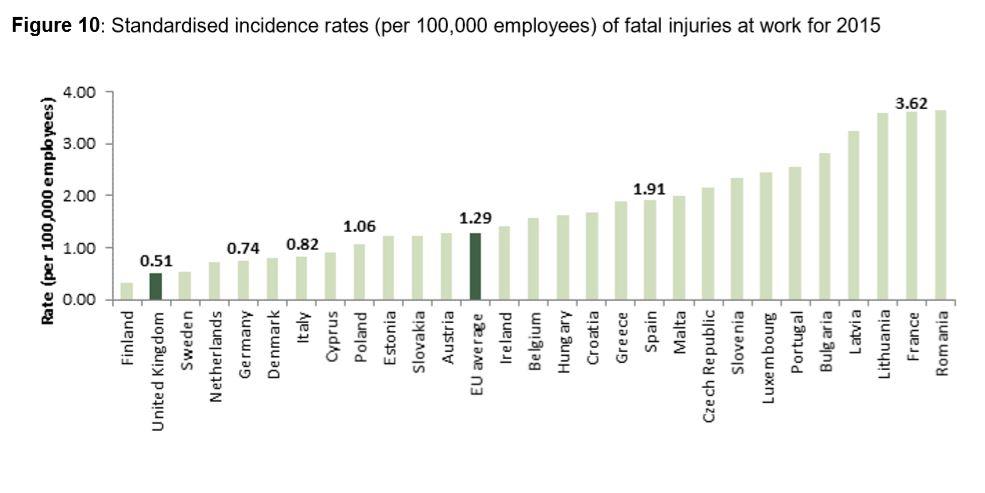05 July 2018
HSE releases annual UK workplace fatality figures
HSE releases annual UK workplace fatality figures – Construction sector fatal accidents rise sharply
Building Safety Group (BSG) issues comment on the HSE construction industry annual statistics as fatal accidents in construction rises sharply.
The Health and Safety Executive (HSE) has released its annual figures for work-related fatal injuries for 2017/18, as well as the number of people known to have died from the asbestos-related cancer, mesothelioma, in 2016.
The HSE revealed that 144 workers were fatally injured between April 2017 and March 2018 (a rate of 0.45 per 100,000 workers). This provisional annual data represents an increase of nine fatalities from 2016/17, however there has been a long-term downward trend in the number of fatal injuries to workers since 1981. Although in recent years, the number has remained broadly level with the average annual number of workers killed at work over the five years 2013/14-2017/18p (the average number is 141).
Construction statistics
Accounting for the largest share of any industry, 38 construction workers sustained fatal injuries in 2017/18, an increase of 27% compared to the lowest number on record (30) for worker deaths in 2016/17.
The rate of fatal injury in construction is now at 1.64 per 100,000 workers employed. This is around four times as high as the average rate across industries but considerably less than the rate in either Agriculture (18 times as high) or Waste and recycling (16 times as high). It should be noted however that the number of fatal injuries in the construction sector has fluctuated in recent years. Some 47 people were killed in 2015/16 compared with the previous year’s total of 35.

Fatal accident risk factors
The three most common causes of fatal injuries continue to be down to: workers falling from height (35), being struck by a moving vehicle (26) and being struck by a moving object (23), accounting for nearly 60 per cent of fatal injuries in 2017/18.

The new figures also highlight the risks to older workers, with 40% of fatal injuries in 2017/18 to workers aged 60 or over, even though such workers made up only around 10% of the workforce.
In addition, there were also 100 members of the public fatally injured in incidents connected to work in 2017/18 with just over half of these fatalities occurring on railways.
Asbestos figures
The latest statistics also show that in 2016 2,595 workers in the UK died from mesothelioma – a cancer often caused by exposure to asbestos at work and one of the few work-related diseases where deaths can be counted directly.
The current figures are largely a consequence of occupational asbestos exposures that occurred before 1980. Of the deaths in 2016, 398 were among women and 2,197 were among men – again this ratio is broadly similar to previous years. The latest projections suggest there will continue to be around 2,500 deaths per year for the rest of this current decade before annual numbers begin to decline.
Global statistics
Britain has consistently had one of the lowest rates of fatal injuries to workers. In 2015, Britain had the lowest rate compared to other leading industrial nations in Europe –France, Germany, Italy, Spain and Poland.

Chris Chapman, Head of CDM Services and Technical Support Manager for BSG commented:
“The construction industry remains four times more dangerous than the national average for other industries, which is reflected by the 27% increase in  construction related deaths this year from 30 to 38. A major seed change in our attitude towards health and safety is needed if we are to improve on these figures and start to show a true reduction to the point where no one is killed at work. This is a perfectly achievable goal with more training and better guidance.
construction related deaths this year from 30 to 38. A major seed change in our attitude towards health and safety is needed if we are to improve on these figures and start to show a true reduction to the point where no one is killed at work. This is a perfectly achievable goal with more training and better guidance.
“Disappointingly, falls from height remains the biggest cause of fatal injuries and is an area where we must improve. Deaths from mesothelioma and other diseases caused by exposure to asbestos are an inheritance from when asbestos was prevalent within all industries but particularly the construction sector. Mesothelioma is almost entirely preventable; it is important that we educate people coming into the industry of how common the use of asbestos was, how dangerous asbestos is and how to guard against exposure. Asbestos is the only known cause of mesothelioma and unfortunately there is no known cure.”
The full report from the HSE can be found here.